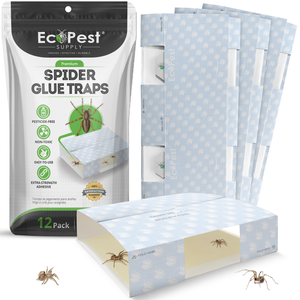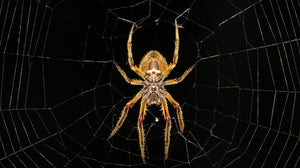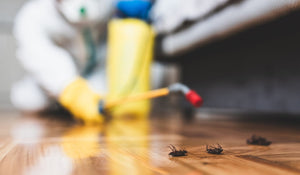
House spiders are widespread in many households, but not all of them are made equal.
Some species are harmless and can even help decrease pest populations, however, others can be harmful to humans and pets. It’s certainly not a pleasant sight to see any pests in your home, but spiders are one of the most disturbing. Before you panic and call the pest exterminating professionals in this post, we will examine the most common house spiders, as well as how to recognize them and whether or not they are dangerous.

What Is the Most Common House Spider?
1. American house spider
The American House Spider, also known as the Common House Spider, is a kind of spider that is commonly found in homes and other man-made structures. They are normally brown or gray in color and around 1/4 inch in length.
They are not poisonous, and their bites do not cause harm to people. They are noted for weaving uneven webs and are frequently seen in room corners, ceilings, and basements. They aren't regarded as hazardous spiders, and they can help manage bug populations, but their webs can look quite messy and that’s why many people use spider glue traps to get rid of them.
2. Black widow
The deadly Black Widow spider is distinguished by its striking black body and crimson hourglass form on the underside of its abdomen. They may be found in various locations in the United States and across the world. They're usually found in dark, concealed places like wood piles, sheds, and basements. Venom from a black widow spider can induce muscular pains, nausea, and, in severe cases, death. If you believe you have been bitten by a Black Widow, get medical care as soon as possible.
It is critical to use caution when handling Black Widows or any other poisonous spider, as bites can be fatal. If you suspect a black widow infestation in your house, it is always better to leave the matter to a professional.
3. Wolf spider
The Wolf Spider is a widespread spider species found around the world, including in the United States. They are usually brown or gray in appearance and can grow to be 1 inch long. Wolf Spiders get their name from their hunting activity and quickness. Wolf spiders do not have venom and their bites are not dangerous to humans. They are nocturnal and can be seen at night foraging for food. When threatened, they are known to be swift, nimble, and aggressive. They often dwell in the ground and may be found in gardens, fields, and other open spaces.
Wolf spiders are not considered threatening to people, but they can be a nuisance if caught indoors.

4. Brown recluse
The Brown Recluse Spider, sometimes known as the Violin Spider or Fiddleback Spider, is a poisonous spider found in the southeastern and central United States. They are typically light to dark brown in color and have a violin-shaped marking on their back, thus the name. Brown Recluse spiders are typically little, measuring around 1/4 inch in length. They are known for their solitary nature and may be found lurking in dark, concealed places such as attics, closets, and basements.
The venom of a Brown Recluse can induce necrosis, or tissue death, and is hazardous if not treated. Their bites can cause extreme pain, fever, and muscular cramps, as well as serious skin infections or even death in certain circumstances. If you believe you have been bitten by a Brown Recluse spider, get medical assistance as soon as possible.
5. Jumping spider
Jumping Spiders are a widespread type of spider found all throughout the world, including the United States. They are well-known for their capacity to jump multiple times their body length, which allows them to catch food swiftly. They are normally tiny, ranging in length from 1/8 inch to 3/4 inch. Their legs are short and thick, and their bodies are normally hairy, with huge front eyes. They are usually brown, black, or gray, with vibrant and colorful patterns on their bodies.
Jumping Spiders do not have venom and their bites are not dangerous to humans. They are known to be inquisitive and may roam around the house, but they are not violent. They are known to be active throughout the day and may be seen on walls, ceilings, and other surfaces. They are recognized to be effective in decreasing bug populations, but if detected inside the house, they may be a nuisance.

6. Daddy longlegs
Daddy Longlegs, commonly known as Harvestmen, are not spiders, but rather arachnids that are closely related to spiders. They are prevalent in many parts of the world, including the United States. They are distinguished by their long, slender legs and tiny, spherical bodies. They can range in length from 1/4 inch to 3/4 inch. They are brown or gray in color and may be found in a range of settings including homes, garages, and sheds.
Daddy Longlegs are not poisonous, and their bites are not dangerous to humans. They are not known to be aggressive, nor do they spin webs. They have been shown to be effective in managing insect populations. They eat tiny insects and can be seen in the house during the fall and winter, so it’s not a bad idea to leave a few of them alive to manage other pests.
7. Hobo spider
The Hobo Spider, sometimes known as the aggressive house spider, is a kind of spider that lives in the Pacific Northwest of the United States and portions of Canada. They are normally brown in hue with an orange-colored marking on the skull. They can reach a body length of 1 inch. They are aggressive and may be discovered in a variety of regions of the home, including basements, crawl spaces, and around foundations.
The venom of a hobo spider can induce regional discomfort, redness, and edema. However, the venom of the Hobo spider is not considered deadly to humans, and its bites seldom need medical care. However, some humans may have serious responses to the venom, so if you believe you have been bitten by a Hobo spider, get medical assistance immediately.

Are All Common House Spiders Dangerous?
Common house spiders are not all dangerous.
In this educational review published in 2014 you can discover more about the most common venomous spiders, the symptoms their bite causes, and how to deal with them:
“More than 40,000 species of spider have been identified to date but the real number is estimated at 4 times more than that number. Except for two small groups in the arachnid family, all spiders have poison glands and release their secretions into their venom sacs near their chelicerae. However, the majority of spiders do not bite humans and except for a few cases, they are not harmful to the human being or other mammals.”
Some species, such as the American House Spider, are completely harmless and can even help to manage pest populations. Other species, such as the Brown Recluse and Black Widow, can be harmful to humans and pets because of their poisonous bites. It is critical to understand how to recognize these spiders and the dangers they may cause, so follow our detailed guide to be sure.
If you believe you have a deadly spider in your house, you should call a professional immediately.

 Tamara Šikloši
Tamara Šikloši





